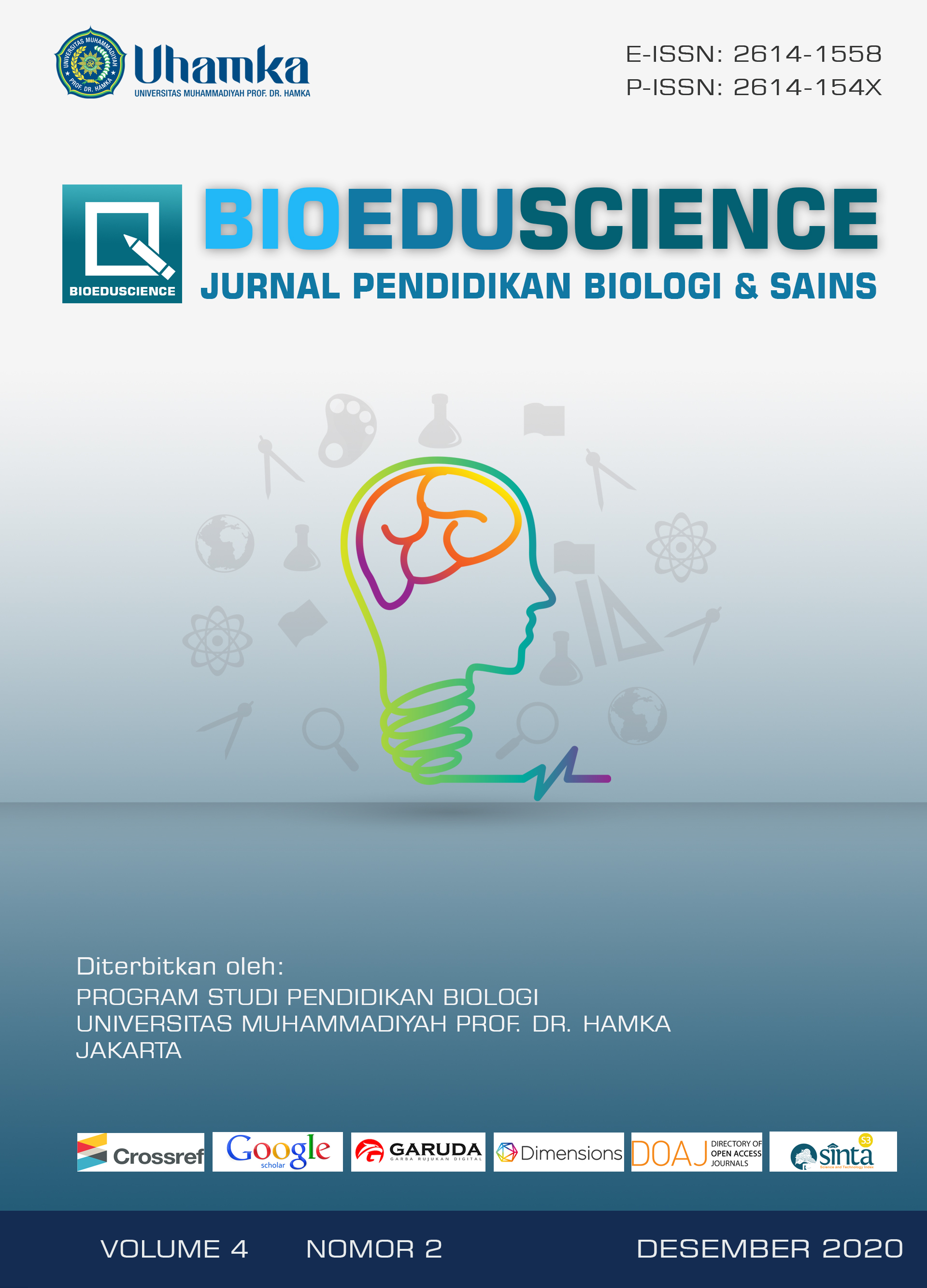Application of a Four-Tier Diagnosis Test for Evaluating Student's Misconception about Blood Classification
Abstract
Background: A misconception is a form of error in scientific knowledge that is believed to be accurate. As a result, someone who has a misconception of something will reject scientific truth and will hinder the assimilation of new knowledge. The purpose of this study was to identify misconceptions that occur in students regarding the topic of blood classification. Methods: The survey method research was conducted on 97 students scattered in Malang and Tulungagung, Indonesia. The data analysis technique uses coding for categorization into four categories: conceptual understanding, partial understanding, misconception, and not understanding the concept. Results: The results showed that misconceptions occurred in all sub-topics of blood classification. Misconceptions were found in the concept of blood plasma (2.1%), white blood cells (6.2%), thrombocytes (17.5%), and blood classification system (8.2%). Misconceptions occur due to several misunderstandings of students such as red blood cells that play a role in transporting nutrients, haemoglobin only binds oxygen, and difficulty distinguishing between antigens and antibodies in determining blood groups, blood donation, and the impact arising from donations. Conclusion: The existence of misconceptions causes students' mastery of blood classification material to be hampered.
Full text article
References
Alfionitari, E., Nurlaeli, N., & Alfriansyah, D. (2019). Identifikasi Miskonsepsi Siswa Dengan Menggunakan Metode Certainty of Response Index (CRI) Pada Materi Pelajaran IPA. Jurnal Pembelajaran Biologi: Kajian Biologi Dan Pembelajarannya, 6(1), 22–30.
Dewi, F. H., Samsudin, A., & Nugraha, M. G. (2019). An investigation of students' conceptual understanding levels on fluid dynamics using four-tier test. Journal of Physics: Conference Series 1280, 052037. https://doi.org/10.1088/1742-596/1280/5/052037
Fatmawati, A., Zubaidah, S., Mahanal, S., & Sutopo. (2019). Critical Thinking, Creative Thinking, and Learning Achievement: How They are Related. Journal of Physics: Conference Series, 1417, 012070. https://doi.org/10.1088/1742-596/1417/1/012070
Fuad, A. Z., Alfin, J., Fauzan, F., Astutik, S., & Prahani, B. K. (2019). Group Science Learning Model to Improve Collaborative Problem Solving Skills and Self-Confidence of Primary Schools Teacher Candidates. International Journal of Instruction, 12(3), 119–132. https://doi.org/10.29333/iji.2019.1238a
Khairaty, N. I., Taiyeb, A. M., & Hartati. (2018). Identifikasi Miskonsepsi Siswa Pada Materi Sistem Peredaran Darah Dengan Menggunakan Three-Tier Test di Kelas XI IPA 1 SMA Negeri 1 Bontonompo. Jurnal Nalar Pendidikan, 6(1).
Kurt, H., Ekici, G., Aksu, O., & Aktas, M. (2013). The most important concept of transport and circulatory systems: Turkish biology student teachers' cognitive structure. Educational Research and Reviews, 8(17), 1574–1593.
Mustofa, Z. (2018). The Description of Student Understanding about Elasticity Concept. Jurnal Penelitian & Pengembangan Pendidikan Fisika, 4(1), 27–34. https://doi.org/10.21009/1.04104
Mustofa, Z. (2019). Pengaruh Discovery Learning Berbantuan E-Learning Dalam Meningkatkan Penguasaan Konsep Dan Aplikasinya. Kwangsan: Jurnal Teknologi Pendidikan, 7(1), 14–29. https://doi.org/10.31800/jtp.kw.v7n1.p14--29
Mustofa, Z., & Asmichatin, A. (2019). Modeling Instruction to Promote Student's Understanding of System and Model of System of Mechanical Energy. Abjadia, 3(1), 17. https://doi.org/10.18860/abj.v3i1.5939
Mustofa, Z., Sutopo, & Mufti, N. (2016). Pemahaman Konsep Siswa SMA Tentang Usaha dan Energi Mekanik (Vol. 1).
Mustofa, Z., Sutopo, S., Mufti, N., & Asmichatin, A. (2019). The Impact of Modeling Instruction Based on System Toward Work-Energy Concept Understanding. Jurnal Penelitian & Pengembangan Pendidikan Fisika, 5(2).
Negoro, R. A., & Karina, V. (2019). Development Of A Four-Tier Diagnostic Test For Misconception Of Oscillation And Waves. Jurnal Penelitian & Pengembangan Pendidikan Fisika, 5(2), 69–76. https://doi.org/10.21009/1.05201
í–zgür, S. (2013). The Persistence of Misconceptions about the Human Blood Circulatory System among Students in Different Grade Levels. International Journal of Environmental and Science Education, 8(2), 255–268. https://doi.org/10.12973/ijese.2013.206a
Pujayanto, P. (2018). Developing Four Tier Misconception Diagnostic Test About Kinematics. Jurnal Cakrawala Pendidikan, 37(2). https://doi.org/10.21831/cp.v37i2.16491
Soeharto, B., C., E., S., F.I., D., & T., S. (2019). A Review of Students' Common Misconceptions in Science and Their Diagnostic Assessment Tools. Jurnal Pendidikan IPA Indonesia, 8(2). https://doi.org/10.15294/jpii.v8i2.18649
Syarafina, Mustofa, Z., & Prayitno, T. A. (2020). Penerapan Soal Four Tier untuk Mengidentifikasi Miskonsepsi Siswa pada Materi Aktivitas Jantung dan Pembuluh Darah. BIOSFER"¯: Jurnal Biologi Dan Pendidikan Biologi, 5(1), 6–13. https://doi.org/10.23969/biosfer.v5i1.2406
Widiyatmoko, A., & Shimizu, K. (2018). An overview of conceptual understanding in science education curriculum in Indonesia. Journal of Physics: Conference Series, 983, 012044. https://doi.org/10.1088/1742-6596/983/1/012044
Authors

This work is licensed under a Creative Commons Attribution 4.0 International License.

